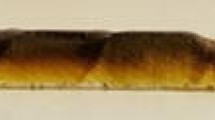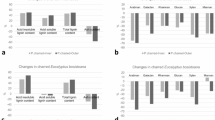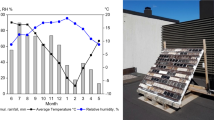Abstract
One-sided surface charring of beech wood (Fagus sylvatica L.) was analyzed. Specimens were charred on one surface using contact heating system with a hot plate, at a temperature of 220 °C and atmospheric pressure for 15 or 40 min. Surface charring was applied on the radial or tangential surface. Spectrophotometric chemical analysis was carried out to determine the total amount of soluble carbohydrates and phenolic compounds beneath the surface in order to evaluate the depth (within 1, 2, 3 and 4 mm) of the degradation affected by the charring. Specimens of dimensions 14 × 14 × 14 mm were used to determine the moisture behavior of charred specimens. The equilibrium moisture content (EMC) of specimens was calculated at a temperature of 20 °C and 65% relative humidity. Water absorption (WA) was recorded during the water immersion for 240 h at various intervals. Finally, the three-point bending tests were undertaken and modulus of rupture (MOR) and modulus of elasticity were calculated. Degradation of the main wood compounds due to chemical changes occurred during the surface charring is closely associated with a mass loss (3.5–5.5%) and further related to the severity of process and orientation of specimens to heat flow. Application of surface charring resulted in the significant reduction in EMC (~ 20%) as a result of a decrease in hydroxyl groups, an increase in cellulose crystallinity as well as further cross-linking of lignin. Furthermore, the WA of one-sided surface-charred wood considerably decreased (15%) when compared to that of the control specimens. A significant increase in soluble carbohydrates as well as phenolic compounds was found, and it can be stated that one-sided charring affected wood properties to depth 2–3 mm from the surface. Significant differences (14–24%) of bending strength MOR results are most likely due to improved sorption behavior of wood. The results show that beech wood charring improved moisture-related characteristics and consequently led to better mechanical behavior, but more studies are needed to exploit the potential of surface charring method for future use.






Similar content being viewed by others
References
Akizuki M, Hasemi Y, Yasui N, Kinoshita K, Yammamoto K, Yoshida M, Tamura Y, Takeda M (2001) Fire safety studies in the restoration of a historic wooden townhouse in Kyoto-fire safety experiments on Japanese Traditional wood based constructions. In: Proceedings 5th AOSFST. Newcastle, pp. 329–340
Albalasmeh AA, Berhe AA, Ghezzehei TA (2013) A new method for rapid determination of carbohydrate and total carbon concentration using UV spectrophotometry. Carbohydr Polym 97(2):253–261
Boonstra M, Tjeerdsma B (2006) Chemical analysis of heat treated softwoods. Holz Roh-Werkstoff 64(3):204–211
BS 373 (1957) Methods of testing small clear specimens of timber. British Standard Institution, London
Browne FL (1958) Theories of the combustion of wood and its control. Report No. 2136. U.S. Department of Agriculture, Forest Service, Forest Products Laboratory: Madison, WI, USA
Čermák P, Rautkari L, Horáček P, Saake B, Rademacher P, Sablík P (2015) Analysis of dimensional stability of thermally modified wood affected by re-wetting cycles. BioResources 10(2):3242–3253
Čermák P, Vahtikari K, Rautkari L, Laine K, Horáček P, Baar J (2016) The effect of wetting cycles on moisture behaviour of thermally modified Scots pine (Pinus sylvestris L.) wood. J Mater Sci 51(3):1504–1511. https://doi.org/10.1007/s10853-015-9471-5
Engelund ET, Thygesen LG, Svensson S, Hill CA (2013) Critical discussion of the physics of wood-water interactions. Wood Sci Technol 47(1):141–161
Esteves B, Velez Marques A, Domingos I, Pereira H (2008) Heat induced colour changes of pine (Pinus pinaster) and eucalypt (Eucalyptus globulus) wood. Wood Sci Technol 42(5):369–384
Esteves B, Pereira H (2009) Wood modification by heat treatment: a review. BioResources 4(1):370–404
Frangi A, Fontana M (2003) Charring rates and temperature profiles of wood sections. Fire Mater 27(2):91–102
Fuwape JA (1996) Effects of carbonisation temperature on charcoal from some tropical trees. Bioresour Technol 57(1):91–94
Gosselink RJA, Krosse AMA, van der Putten JC, van der Kolk JC, de Klerk-Engels B, van Dam JEG (2004) Wood preservation by low-temperature carbonisation. Ind Crops Prod 19(1):3–12
Hakkou M, Pétrissans M, Zoulalian A, Gérardin P (2005) Investigation of wood wettability changes during heat treatment on the basis of chemical analysis. Polym Degrad Stab 89(1):1–5
Hakkou M, Pétrissans M, Gérardin P, Zoulalian A (2006) Investigation of the reasons for fungal durability of heat-treated beech wood. Polym Degrad Stab 91(2):393–397
Hill C (2006) Wood modification chemical, thermal and other processes. Wiley series in: renewable resources. Wiley, Hoboken
Hill C (2011) Wood modification: an update. BioResources 6(2):918–919
Hill CA, Ramsay J, Keating B, Laine K, Rautkari L, Hughes M, Constant B (2012) The water vapour sorption properties of thermally modified and densified wood. J Mater Sci 47(7):3191–3197. https://doi.org/10.1007/s10853-011-6154-8
Jämsä S, Viitaniemi P (2001) Heat treatment of wood—better durability without chemicals. In: Proceedings of special seminar held in Antibes, France
Kutnar A, Muthu SS (2016) Environmental impacts of traditional and innovative forest-based bioproducts. Springer, Berlin, p 248
Kymäläinen M, Hautamäki S, Lillqvist K, Segerholm K, Rautkari L (2017) Surface modification of solid wood by charring. J Mater Sci 52(10):6111–6119. https://doi.org/10.1007/s10853-017-0850-y
Kymäläinen M, Turunen H, Čermák P, Hautamäki S, Rautkari L (2018) Surface-related characteristics of surface charred spruce wood. Materials 11(11):2083–2097
Militz H (2002) Thermal treatment of wood: European processes and their background. International Research Group on Wood Preservation, Document no. IRG/WP 02-40241, Stockholm, Sweden
Mitsui K, Inagaki T, Tsuchikawa S (2008) Monitoring of hydroxyl groups in wood during heat treatment using NIR spectroscopy. Biomacromolecules 9(1):286–288
Niemz P, Hofmann T, Rétfalvi T (2010) Investigation of chemical changes in the structure of thermally modified wood. Maderas Ciencia y Technologia 12(2):69–78
Pfriem A (2006) Untersuchungen zum Materialverhalten thermisch modifizierter Hölzer für deren Verwendung im Musikinstrumentenbau. Ph.D. Dissertation, TU Dresden, Germany
Pohler E, Klingner R, Kunniger T (2006) Beech (Fagus sylvatica L.)—technological properties, adhesion behavior and colour stability with and without coatings of the red heartwood. Ann For Sci 63(2):129–137
Požgaj A, Chovanec D, Kurjatko S, Babiak M (1997) Štruktúra a vlastnosti dreva. Príroda, a. s., Bratislava, 488 p
Rautkari L, Hill C (2014) Effect of initial moisture content on the anti-swelling efficiency of thermally modified Scots pine sapwood treated in a high-pressure reactor under saturated steam. Holzforschung 68(3):323–326
Rowell RM (2005) Handbook of wood chemistry and wood composites. CRC Press, Florida, p 487
Singleton VL, Rossi JA (1965) Colorimetry of total phenolic with phosphomolybdic–phosphotungstic acid reagent. Am J Enol Viticult 16:144–158
Siau JF (1984) Transport processes in wood. Springer, Berlin
Sonderegger W, Vecellio M, Zwicker P, Niemz P (2011) Combined bound water and water vapour diffusion of Norway spruce and European beech in and between the principal anatomical directions. Holzforschung 65(6):819–828
Steinhagen PH (1977) Thermal conductive properties of wood, green or dry, from − 40° to + 100° C: a literature review. USDA Forest Service General Technical Report FPL-9, Forest Products Laboratory, Madison, WI
Syrjänen T, Jämsä S, Viitaniemi P (2000) Heat treatment of wood in Finland. In: Proceedings of seminar “production and development of heat treated wood in Europe”, Nov. 2000, Helsinki, Stockholm, Oslo
Telkki VV, Saunavaara J, Jokisaari J (2010) Time-of-flight remote detection MRI of thermally modified wood. J Magn Reson 202(1):78–84
Tjeerdsma B, Boonstra M, Pizzi A, Tekely P, Militz H (1998) Characterisation of thermaly modified wood: molecular reasons for wood performance improvement. Holz Roh-Werkst 56(3):149–153
Tjeerdsma B, Militz H (2005) Chemical changes in hydrothermal treated wood: FTIR analysis of combined hydrothermal and dry heat-treated wood. Eur J Wood Wood Prod 63(2):102–111
Viitanen H, Jämsä S, Paajanen L, Nurmi A, Viitaniemi P (1994) The effect of heat treatment on the properties of spruce—a preliminary report. International Research group on Wood Preservation. Document No. IRG/WP 94–40032
Viitaniemi P, Jämsä S, Viitanen H (1997) Method for improving biodegradation resistance and dimensional stability of cellulosic products, United States Patent No. 5678324 (US005678324)
Wagenführ R (2007) Holzatlas (wood atlas). Fachbuchverlag Leipzig im Hanser-Verlag, München
Weiland JJ, Guyonnet R (2003) Study of chemical modifications and fungi degradation of thermally modified wood using DRIFT spectroscopy. Holz Roh-Werkst 61(3):216–220
Yan L, Morrell J (2014) Effects of thermal modification on physical and mechanical properties of Douglas-fir heartwood. BioResources 9(4):7152–7161
Acknowledgements
This work was financially supported by Grant Agency of the Czech Republic (GAČR), Project No. 19-25171Y “Multi-scale Hygro-thermo-mechanical Behavior of Modified Wood-based Materials”.
Author information
Authors and Affiliations
Corresponding author
Additional information
Publisher's Note
Springer Nature remains neutral with regard to jurisdictional claims in published maps and institutional affiliations.
Rights and permissions
About this article
Cite this article
Čermák, P., Dejmal, A., Paschová, Z. et al. One-sided surface charring of beech wood. J Mater Sci 54, 9497–9506 (2019). https://doi.org/10.1007/s10853-019-03589-3
Received:
Accepted:
Published:
Issue Date:
DOI: https://doi.org/10.1007/s10853-019-03589-3




